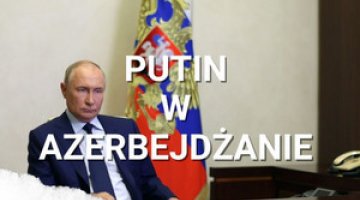Eyes west! A shift in focus in Russia’s Southern Military District

Since the collapse of the Soviet Union, the Southern Military District (SMD), which is the smallest of all the main administrative units of the Armed Forces of the Russian Federation in terms of landmass, has been one of the most powerful districts and one of those playing the greatest roles in the armed conflicts in which Russia is engaged. In the two Chechen wars and the strike against Georgia in 2008, it bore the main brunt, and at present currently, along with the Black Sea Fleet (which is under its command), it bears the main responsibility for operations against Ukraine and for the military operation in Syria.
Until the mid-2010s, the natural theatre for operations and area of SMD military activity was: the Caucasus, Turkey, the Middle East, and Iran. The conflict with Ukraine caused the SMD’s centre of gravity to shift to regions directly bordering Ukraine and occupied Crimea. The changes to the structure and the twofold increase in the SMD’s capability observed since that time show that the southern direction is no longer a priority. Examples of this increase include: the forming of the new 8th Army (A) on the Ukraine border and expansion of the group in Crimea. The vast majority of SMD units are currently preparing for operations in the western direction. Ukraine has become the main target, but if a conflict should break out on NATO’s eastern flank, the SMD’s task would be to provide direct support for operations in Central Europe.
The source of the shift in strategy
The SMD inherited the area, with no substantial change, from the North Caucasus Military District, which existed from 1918 until 2010. The only change to this area was the addition of Crimea, which was occupied in 2014. It also inherited the same structure, until the conflict with Ukraine broke out. Compared to the other military districts of the Russian army (the Western, Central and Eastern Districts), formed when parts of the administrative military units that used to exist were merged or divided up, this is a major event and demonstrates the importance that the command of the Armed Forces of the Russian Federation continually attached to the southern strategic direction. The North Caucasus Military District was one of the most powerful military districts when there were six military districts in Russia, while the Southern Military District remained strong when the number was reduced to four.
The SMD continued to be of major importance chiefly due to a change made in 2010 to the command system of the Armed Forces of the Russian Federation, when the military district command was restructured as a joint strategic command due to it being put in charge of all of the service branches based in the district (except the strategic nuclear forces). As a result of this process, the capability of the North Caucasus Military District[1] at the time the SMD (the Southern Joint Strategic Command) was formed was enlarged to include the Black Sea Fleet (BSF) and Caspian Flotilla (CFL). This makes the SMD, presently and in the foreseeable future, the only military district in charge of two Russian Federation Navy operational groups.[2]
Originally, the forming of the SMD did not lead to any changes to the direction and area of operations or plans to enhance its capability other than it becoming more professional and receiving a technical upgrading. The current operational formations (armies) and military bases (equivalents of mechanised brigades) under the district’s command in Armenia and in the occupied territories in Georgia (within the ‘republics of Abkhazia and South Ossetia’) led to the creation of a group sufficient to monitor the military situation and respond directly should the situation take a turn unfavourable for Russia south of the Caucasus massif.
The enhancing of capability in the European direction, ongoing since 2013, originally only concerned the Western Military District. The SMD was included in this process due to the turn taken in the military situation in Donbas in August 2014, where Russia caused a direct armed confrontation with the Ukrainian army. The operation to cause the breakaway of Ukraine’s southern and eastern districts (referred to in Russian propaganda as ‘Little Russia’) by creating and supporting separatist movements, the attaining of proficiency by Ukraine’s armed forces, and the forming of entrenched frontline positions in Donbas ended in failure. This led to part of the command realising that if a full-scale armed conflict broke out, a permanent and strong group would need to be maintained in the border regions.
Expanding the group in the direction of Ukraine
Russia began increasing its military presence in Ukraine’s occupied territories – Crimea and part of Donbas (officially under the administration of separatists from the ‘Donetsk and Luhansk People’s Republics’) – immediately upon taking over the territories. Up until September 2014, which saw the first in a long line of ceasefires, the reinforcement of Russia’s military presence on the Crimean Peninsula and in the eastern districts of Ukraine was not permanent and was solely related to the possible escalation of military action, including to the level of a regular war between Russia and Ukraine. Not only SMD units, but also subunits (such as the ‘little green men’) from the other military districts took part in the operation.
As early as autumn 2014, any measures to maintain a Russian military presence and expand the military capability in the occupied areas were put under SMD command. At the same time, the group created in Crimea came under the charge of the BSF (which was under SMD command) and this was in the occupied part of Donbas, the ‘Donetsk and Luhansk People’s Republics’. This paper will not deal with the subject of armed formations of separatists,[3] but it needs to be borne in mind that since they came into existence they have been operational structures under SMD command (the district command is located in nearby Rostov-on-Don), and the SMD is the natural and sole supporting force for them.[4]
Since the collapse of the Soviet Union, the core of the Russian BSF has been continually stationed in Crimea, while the land and air components of the fleet, concentrated in the vicinity of Sevastopol, have been relatively few in number. They were mostly formed from independent subunits in service branches, and the only tactical formation was the 810th Naval Infantry Brigade. While the importance of the peninsular for the marine component of the BSF remained unchanged from 2014 onwards, the increase of land and air capability observed since it was annexed by Russia has probably exceeded the levels of Soviet times.
Before the collapse of the USSR, the role of the group in Crimea was confined solely to shielding the BSF. Today, on the other hand, it is also responsible for organising auxiliary operations in the armed conflict with Ukraine (including expansion of the offensive on the coastal belt). This is demonstrated by the forming of the 22nd Army Corps in February 2017. This is made up exclusively of new units (i.e. ones formed since 2014), led by the 126th Coastal Defence Mechanised Brigade. It does not include units directly responsible for shielding and supporting the Sevastopol base and marine component of the BSF (this part of the group has also been considerably enlarged).
The organising and development of the military capability in occupied Crimea was the first change that followed the shift in the strategic focus of the SMD, but it was not the largest or the most significant. The forming, largely from scratch, of the 8th A, which is the largest operational formation in the Armed Forces of the Russian Federation created in recent years, was unprecedented in terms of the entire Russian army. The core of the unit is the 150th Mechanised Division – one of the first two tactical formations formed in Russia since Soviet times in a wartime structure from the outset,[5] meaning it was formed with four all-military full-time regiments. In addition, this division has two tank regiments and is currently the heaviest mechanised division in the Russian army. Together with the other tactical formations and independent units and subunits, at the level of the army, the 8th A soon became the SMD operational formation with the second largest capability, only slightly behind the 58th A.
To become operationally capable as soon as possible, the 8th A was initially formed at the expense of the 49th A, which had primary responsibility for operations in the Caucasus. Among others, two out of four mechanised brigades were moved from the 49th A to the 8th Army.[6] In the meantime, the 8th A was reinforced by an artillery brigade, which this operational formation was lacking. As a result of the transformation, the 49th A became, in relative terms, the weakest of the three SMD combined arms armies. Although, in the long term, expansion of its structures cannot be ruled out, the changes observed confirm the theory that the southern direction is no longer a priority in the operational plans of the SMD, while the centre of gravity of the whole strategic direction – which, in name, continues to be towards the south – has shifted westwards. This is demonstrated not only by the way in which the 8th Army was formed, but also by changes occurring in the third SMD operational formation – the 58th A – to adapt it to conduct operations as a second force in the direction of Ukraine.[7]
Although, since 2015, the main task of the BSF has been to provide support for the Russian contingent in Syria, changes to the fleet’s marine component are another element indicating preparations for operations in Europe. Over the last five years, the number of BSF battleships has doubled, and the number of submarines has risen sixfold (originally there was one), while all of the frigates, missile corvettes and submarines put into service are platforms for Kalibr cruise missiles. This means that their main task in the event of a conflict in the Black Sea region will be direct support of air and land operations (not only Ukraine and NATO’s Black Sea countries, but the whole of Central Europe is within the range of Kalibr missiles). Prior to 2014, the BSF did not have this capability at all.
The Southern Military District, 2020
The expansion of structures as described above and the formation of new SMD units, alongside the fact that personnel are now professional and the technical upgrades, means that the capability of the SMD has probably at least doubled over the last six years (see appendix for a detailed comparison). The district now has four all-military operational formations – three armies and one army corps, as well as one Air and Air Defence Forces army, and a fleet and independent flotilla in the Navy. Compared to the first half of this decade, the number of troops has increased in peacetime from 70,000 to more than 100,000 (not including crews of ships in the BSF and CFL).[8] However, a simple quantitative comparison does not reflect the extent to which the offensive capability of the group of the Armed Forces of the Russian Federation has increased in the strategic direction that is still nominally directed towards the south. In linear units there are almost 800 tanks, more than 2,500 armoured combat vehicles, more than 2,000 100 mm and higher calibre artillery pieces, 240 combat aircraft, and 130 combat and combat support helicopters.[9]
The BSF and CFL jointly have more than 70 ships (not including auxiliary units) and six submarines (all in the BSF).[10] Units are being equipped with new arms or thoroughly upgraded arms and military equipment at a level of between 70% (the envisaged level under the State Armament Programme for 2011–2020) and 100% (for example in the case of missile brigades equipped with Iskander systems and the submarine brigade).[11]
In terms of the number of professional personnel and the level of training activity, the SMD does not differ from the other military districts.[12] It does, though, have one specific characteristic: the relatively high portion of exercises conducted on training grounds in mountainous terrain. However, due to the change in strategic focus described above, these are no longer the principal form of training in training programmes. The SMD has, though, become the leader in organising joint exercises involving land, sea and air formations, while the vast majority of these exercises are held in the Black Sea basin and Black Sea regions (mainly Crimea and Kuban).
In addition to completing the formation of new units and expanding the existing units to wartime levels (mainly the 8th A), it has been announced that two more divisions will be created, neither of which will be assigned for operations in the Caucasus. Expansion of the 19th Mechanised Brigade to the level of a division, from the 58th A, is already in progress and all that remains is for it to be officially confirmed that the 19th Mechanised Division has been reconstructed.[13] Forming another division, probably based on the 20th Mechanised Brigade in the 8th Army,[14] should begin no later than by 2021. The new tactical formations should be considered an addition to make up the first- and second-force SMD army to a level giving it superiority over the Ukrainian army, enabling it to prepare and conduct military operations against Ukraine relatively independently.
Conclusions
Over a period of six years, the centre of gravity of the SMD has shifted from the Caucasus to regions directly bordering Ukraine and occupied Crimea. The district has not lost its traditional role of a group ready to conduct operations in the Southern Caucasus, but the direction in which its capability is being expanded demonstrates that this is no longer considered a priority. The principal operational direction for the (nominally) Southern Military District is now the western direction. The announced further expansion of SMD forces will be the foundation for the shift in the SMD’s strategic focus.
Training endeavours, starting with the Caucasus 2016 command-and-staff strategic exercises, are a clear indication that the main target of SMD forces, and their adversary, is Ukraine. In 2016, the district did not yet have the capability, if needed, to conduct a military operation against Ukraine because the formation of the 8th A and 22nd Army Corps had only just begun. Although the restructuring of the SMD, especially the formation of two new divisions, will take a minimum of two years to complete, the Caucasus 2020 command-and-staff strategic exercises scheduled for September 2020 will be its first real test. The codename ‘endeavour’ can currently be interpreted at best as a sign of attachment to tradition because, regardless of which training ground SMD units enter during the exercises, and how official statements are worded, the staffs’ main objective will be to simulate a military operation against Ukraine, and the troops’ main objective will be to simulate a confrontation with the Ukrainian army.
APPENDIX
Table 1. Changes in the numbers of operational and tactical formations of Land Forces, Airborne Forces, and Naval Land and Coastal Forces (all-military forces and support) under SMD command in 2014–2020 (as at the beginning of the year)
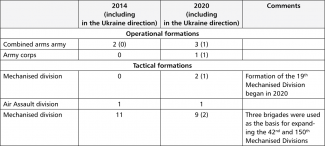

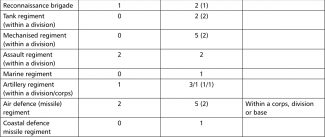
Table 2. Changes in the numbers of operational and tactical formations of Aerospace Forces and of Naval Aviation under SMD command in 2014–2020 (as at the beginning of the year)
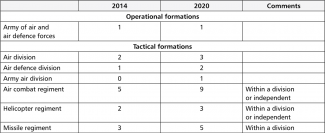
Table 3. Changes in the numbers of surface combatants and submarines under SMD command in 2014–2020 (as at the beginning of the year)
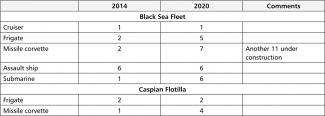
[1] The core was the 49th and 58th Army and 4th Air and Air Defence Forces Army.
[2] Originally, the Western Military District was in a comparable situation, in command of the Baltic and Northern Fleet, but in 2015 the Joint Strategic Command ‘North’ (Arctic) was formed using the Northern Fleet and, from 2021, the Northern (Arctic) Military District will be created from the northern part of the Western Military District and islands on the Arctic Ocean which were previously part of the Central and Eastern Military Districts.
[3] Primarily due to the organisational and technical differences between Russia maintained between those and the regular formations of the Armed Forces of the Russian Federation, and not administrative matters. In the ‘Donetsk and Luhansk People’s Militias’ – despite being reinforced by Russian army personnel and replenished from Russian stores – a pretence of them being separate is maintained, mainly with regard to equipment (which incidentally makes armed provocation by separatists easier).
[4] The relationship between the SMD and armed separatist formations in Abkhazia and South Ossetia is comparable, while regular SMD units are also stationed in those republics.
[5] Including the Central Military District 90th Armoured Division – both units were created on 1 December 2016. At the moment all of the Russian divisions, previously existing and newly formed, have adopted a wartime structure, i.e. four regiments.
[6] The 33rd Mechanised Brigade, one of two brigades in the Armed Forces of the Russian Federation specially trained to operate in mountainous terrain, was the basis for the 150th Mechanised Division.
[7] The mass equipping of the 150th Mechanised Division with the latest mass-produced infantry combat vehicle – the BMP-3 – was a technical indication of the SMD’s preparations for operations in the conditions of the Great European Plain. This is the main infantry combat vehicle in the 8th A and 58th A, and the SMD uses the highest number of vehicles of this kind in the Russian army (480 or more in number).
[8] Author’s estimates based on the number and structure of units.
[9] Author’s calculations based on Южный военный округ (www.milkavkaz.com) and Russian Federation Ministry of Defence and press agencies (TASS, Interfax) data.
[10] Author’s calculations based on www.milkavkaz.com – Черноморский флот РФ, Каспийская флотилия РФ – and Russian Federation Ministry of Defence and press agencies (TASS, Interfax) data.
[11] ‘Поступление современной техники в войска ЮВО’, Красная звезда, 25 May 2020, redstar.ru, et al.
[12] 20% are conscripted, which is just over 1 million troops in the Armed Forces of the Russian Federation, and this is comparable to all of the military districts.
[13] Г. Дзапаров, ‘Во Владикавказе прошла первая репетиция парада Победы’, Iryston.tv, 17 June 2020, www.iryston.tv.
[14] И. Сафронов, А. Никольский, ‘Новая мотострелковая дивизия укрепит группировку на границе с Украиной’, Ведомости, 22 March 2020, www.vedomosti.ru. According to some sources, expansion of the division based on the 136th Mechanised Brigade is also being considered, but this is doubtful due to the base’s location (Dagestan) and the fact that the unit was formed as a brigade from the outset, even in the times of the USSR. The 19th and 20th Mechanised Brigades were created based on the reduced divisions of the same names.




